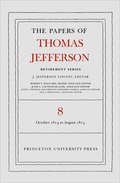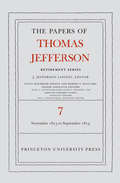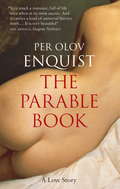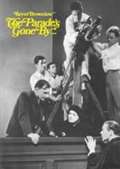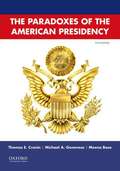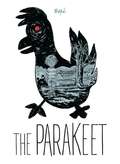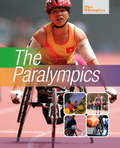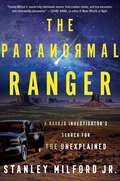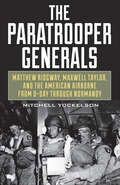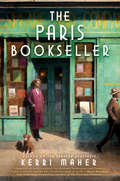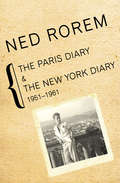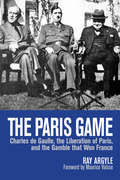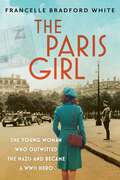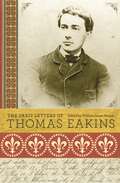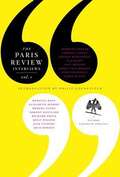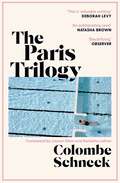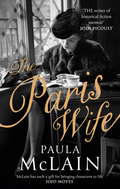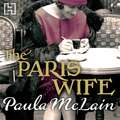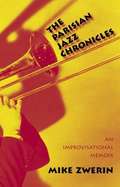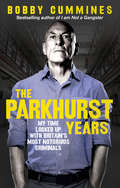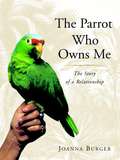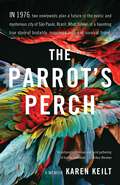- Table View
- List View
The Papers of Thomas Jefferson, Retirement Series: 1 October 1814 to 31 August 1815
by Thomas Jefferson J. Jefferson LooneyVolume Eight of the project documenting Thomas Jefferson's last years presents 591 documents dated from 1 October 1814 to 31 August 1815. Jefferson is overjoyed by American victories late in the War of 1812 and highly interested in the treaty negotiations that ultimately end the conflict. Following Congress's decision to purchase his library, he oversees the counting, packing, and transportation of his books to Washington. Jefferson uses most of the funds from the sale to pay old debts but spends some of the proceeds on new titles. He resigns from the presidency of the American Philosophical Society, revises draft chapters of Louis H. Girardin's history of Virginia, and advises William Wirt on revolutionary-era Stamp Act resolutions. Jefferson criticizes those who discuss politics from the pulpit, and he drafts a bill to transform the Albemarle Academy into Central College. Monticello visitors Francis W. Gilmer, Francis C. Gray, and George Ticknor describe the mountaintop and its inhabitants, and Gray's visit leads to an exchange with Jefferson about how many generations of white interbreeding it takes to clear Negro blood. Finally, although death takes his nephew Peter Carr and brother Randolph Jefferson, the marriage of his grandson Thomas Jefferson Randolph is a continuing source of great happiness.
The Papers of Thomas Jefferson, Retirement Series: 28 November 1813 to 30 September 1814
by Thomas Jefferson J. Jefferson LooneyThe 526 documents printed in this volume run from 28 November 1813 to 30 September 1814. During this period Jefferson reviews the extant sources on the 1765 Stamp Act crisis to aid William Wirt, a Patrick Henry scholar; records his largely positive impressions of George Washington; and updates a reading list for law students that he had initially drawn up forty years earlier. In the spring of 1814 Jefferson becomes a trustee of the Albemarle Academy, the earliest direct ancestor of the University of Virginia. He is soon actively involved in planning for its establishment, helping to draft rules for governance of the academy's trustees and propose funding options, and he lays out an expansive vision for its future as an institution of higher learning. Jefferson also exchanges ideas on collegiate education with such respected scholars as Thomas Cooper and José Corrêa da Serra. Jefferson's wide-ranging correspondence includes a temperate response to a lengthy letter from Miles King urging the retired president to reflect on his personal religion, and a diplomatic but noncommittal reply to a proposal by Edward Coles that the author of the Declaration of Independence employ his prestige to help abolish slavery. Having learned of the British destruction late in August 1814 of the public buildings in Washington, Jefferson offers his massive book collection as a replacement for the Library of Congress. The nucleus for one of the world's great public libraries is formed early in 1815 when the nation purchases Jefferson's 6,707 volumes.
The Parable Book
by Per Olov Enquist Deborah Bragan-Turner"The love that dare not speak its name . . ." Sweden, 1949. A boy of 15, cutting across a garden, chances upon a woman of 51. What ensues is cataclysmic, life-altering. All the more because it cannot be spoken of. Can it never be spoken of?Looking back in late old age at an encounter that transformed him suddenly yet utterly, P.O. Enquist, a titan of Swedish letters, has decided to "come out" - but in ways entirely novel and unexpected. He has written the book that smoldered unwritten within him his entire life. The book he had always seen as the one he could not write.This poignant memoir of love as a religious experience - as a modern form of the Resurrection - is also a deeply felt reflection on the transitoriness of friendship, the fraught nature of family relationships, and the importance of giving voice to what cannot be forgotten. A parable as hauntingly intense as any Bergman film.Translated from the Swedish by Deborah Bragan-Turner
The Parable Book
by Per Olov Enquist"The love that dare not speak its name . . ." Sweden, 1949. A boy of 15, cutting across a garden, chances upon a woman of 51. What ensues is cataclysmic, life-altering. All the more because it cannot be spoken of. Can it never be spoken of?Looking back in late old age at an encounter that transformed him suddenly yet utterly, P.O. Enquist, a titan of Swedish letters, has decided to "come out" - but in ways entirely novel and unexpected. He has written the book that smoldered unwritten within him his entire life. The book he had always seen as the one he could not write.This poignant memoir of love as a religious experience - as a modern form of the Resurrection - is also a deeply felt reflection on the transitoriness of friendship, the fraught nature of family relationships, and the importance of giving voice to what cannot be forgotten. A parable as hauntingly intense as any Bergman film.Translated from the Swedish by Deborah Bragan-Turner
The Parade's Gone By
by Kevin BrownlowThe magic of the silent screen, illuminated by the recollections of those who created it.
The Paradoxes Of The American Presidency
by Meena Bose Michael Genovese Thomas CroninIn The Paradoxes of the American Presidency, now THREE prize-winning presidential scholars, Thomas E. Cronin and Michael A. Genovese and Meenekshi Bose, explore the complex institution of the American presidency by presenting a series of paradoxes that shape and define the office. Rewrittenand updated to reflect recent political events - including the presidency of Barack Obama, the 2012, 2014 elections, with greater emphasis on the importance of midterm election on the Presidency, and the primary and presidential election of 2016. This must read fifth edition incorporates findingsfrom the latest scholarship, recent elections and court cases, and essential survey research.The fifth edition is a major revision-reducing length, increasing the emphasis on the theme of paradoxes, now making the text more appropriate to be used in conjunction with other texts, regardless of whether they take a historical, institutional, or leadership approach.
The Paradoxes of the American Presidency
by Thomas E. Cronin Michael A. GenoveseAnalysis of the Office and its demands.
The Parakeet
by Hannah EspéBastien is eight years old, and his mother is ill. She often has what his father and grandparents call "episodes." She screams and fights, scratches and spits, and has to be carted away to specialized clinics for frequent treatments. Bastien doesn’t like it when she goes, because when she comes home, she isn't the same. She has no feelings, no desires, and not much interest in him. According to the doctors, Bastien’s mother suffers from "bipolar disorder with schizophrenic tendencies," but he prefers to imagine her as a comic-book heroine, like Jean Grey, who may become Dark Phoenix and explode in a superhuman fury at any moment.Based on the creator’s own childhood experiences, The Parakeet is the story of a boy whose only refuge from life’s harsh realities lies in his imagination. In his eyes, we see the confusion and heartache he feels as he watches his mother’s illness worsen and the treatments fail. Through his eyes, we see how mental illness can both tear families apart and reaffirm the bonds of love. Poignant yet playful, The Parakeet follows Bastien’s struggle to accept the mother he has while wishing for the mother he needs.
The Paralympics
by Nick HunterThis book looks at the Paralympics, from the athletes and the sports to the stadiums and the spectators!
The Paralympics (The Olympics #1)
by Nick HunterThis book looks at the Paralympics, from the athletes and the sports to the stadiums and the spectators!
The Paranormal Ranger: A Navajo Investigator's Search for the Unexplained
by Stanley Milford, Jr.*A NEW YORK TIMES PICK FOR TOP 22 NONFICTION BOOKS TO READ THIS FALL!*A Navajo Ranger’s chilling and clear-eyed memoir of his investigations into bizarre cases of the paranormal and unexplained in NavajolandAs a Native American with parents of both Navajo and Cherokee descent, Stanley Milford Jr. grew up in a world where the supernatural was both expected and taboo, where shapeshifters roamed, witchcraft was a thing to be feared, and children were taught not to whistle at night. In his youth, Milford never went looking for the paranormal, but it always seemed to find him. When he joined the fabled Navajo Rangers—a law enforcement branch of the Navajo Nation who are equal parts police officers, archeological conservationists, and historians—the paranormal became part of his job. Alongside addressing the mundane duties of overseeing the massive 27,000-square-mile reservation, Milford was assigned to utterly bizarre and shockingly frequent cases involving mysterious livestock mutilations, skinwalker and Bigfoot sightings, UFOs, and malicious hauntings.In The Paranormal Ranger, Milford recounts the stories of these cases from the clinical and deductive perspective of a law enforcement officer. Milford’s Native American worldview and investigative training collide to provide an eerie account of what logic dictates should not be possible.
The Paratrooper Generals: Matthew Ridgway, Maxwell Taylor, and the American Airborne from D-Day through Normandy
by Mitchell YockelsonA military history detailing the key role two US Army special forces commanders and their infantry divisions played in during the second world war. Generals during World War II usually stayed to the rear, but not Matthew Ridgway and Maxwell Taylor. During D-Day and the Normandy campaign, these commanders of the 82nd &“All-American&” and the 101st &“Screaming Eagle&” Airborne Divisions refused to remain behind the lines and stood shoulder-to-shoulder with their paratroopers in the thick of combat. Jumping into Normandy during the early hours of D-Day, Ridgway and Taylor fought on the ground for six weeks of combat that cost the airborne divisions more than forty percent casualties. The Paratrooper Generals is the first book to explore in depth the significant role these two division commanders played on D-Day, describing the extraordinary courage and leadership they demonstrated throughout the most important American campaign of World War II.
The Paris Bookseller
by Kerri MaherOne of SheReads&’ Best Literary Historical Fiction Coming in 2022 One of Reader&’s Digest&’s Best Books for Women Written by Female Authors The dramatic story of how a humble bookseller fought against incredible odds to bring one of the most important books of the 20th century to the world in this new novel from the author of The Girl in White Gloves. When bookish young American Sylvia Beach opens Shakespeare and Company on a quiet street in Paris in 1919, she has no idea that she and her new bookstore will change the course of literature itself. Shakespeare and Company is more than a bookstore and lending library: Many of the prominent writers of the Lost Generation, like Ernest Hemingway, consider it a second home. It's where some of the most important literary friendships of the twentieth century are forged—none more so than the one between Irish writer James Joyce and Sylvia herself. When Joyce's controversial novel Ulysses is banned, Beach takes a massive risk and publishes it under the auspices of Shakespeare and Company. But the success and notoriety of publishing the most infamous and influential book of the century comes with steep costs. The future of her beloved store itself is threatened when Ulysses' success brings other publishers to woo Joyce away. Her most cherished relationships are put to the test as Paris is plunged deeper into the Depression and many expatriate friends return to America. As she faces painful personal and financial crises, Sylvia—a woman who has made it her mission to honor the life-changing impact of books—must decide what Shakespeare and Company truly means to her.
The Paris Diary & The New York Diary, 1951–1961: 1951-1961
by Ned RoremIn the earliest published diaries of Ned Rorem, the acclaimed American composer recalls a bygone era and its luminaries, celebrates the creative process, and examines the gay culture of Europe and the US during the 1950sOne of America&’s most significant contemporary composers, Ned Rorem is also widely acclaimed as a diarist of unique insight and refreshing candor. Together, his Paris Diary, first published in 1966, and The New York Diary,which followed a year later, paint a colorful landscape of Rorem&’s world and its famous inhabitants, as well as a fascinating self-portrait of a footloose young artist unabashedly drinking deeply of life. In this amalgam of forthright personal reflections and cogent social commentary, unprecedented for its time, Rorem&’s anecdotal recollections of the decade from 1951 to 1961 represent Gay Liberation in its infancy as the author freely expresses his open sexuality not as a revelation but as a simple fact of life. At once blisteringly honest and exquisitely entertaining, Rorem&’s diaries expound brilliantly on the creative process, following their peripatetic author from Paris to Morocco to Italy and back home to America as he crosses paths with Picasso, Cocteau, Gide, Boulez, and other luminaries of the era. With consummate skill and unexpurgated insight, a younger, wilder Rorem reflects on a bygone time and culture and, in doing so, holds a revealing mirror to himself.
The Paris Game: Charles de Gaulle, the Liberation of Paris, and the Gamble that Won France
by Ray Argyle Maurice VaïsseAt a crucial moment in the Second World War, an obscure French general reaches a fateful personal decision: to fight on alone after his government’s flight from Paris and its capitulation to Nazi Germany. Amid the ravages of a world war, three men — a general, a president, and a prime minister — are locked in a rivalry that threatens their partnership and puts the world’s most celebrated city at risk of destruction before it can be liberated. This is the setting of The Paris Game, a dramatic recounting of how an obscure French general under sentence of death by his government launches on the most enormous gamble of his life: to fight on alone after his country’s capitulation to Nazi Germany. In a game of intrigue and double-dealing, Charles de Gaulle must struggle to retain the loyalty of Winston Churchill against the unforgiving opposition of Franklin Roosevelt and the traitorous manoeuvring of a collaborationist Vichy France. How he succeeds in restoring the honour of France and securing its place as a world power is the stuff of raw history, both stirring and engrossing.
The Paris Girl: The Young Woman Who Outwitted the Nazis and Became a WWII Hero
by Francelle Bradford WhiteMovingly written by her own daughter, this captivating and intimate biography chronicles the astonishing courage Andrée Griotteray, a teenage girl in Nazi-occupied Paris who would become a hero of the French Resistance through her harrowing work as an underground intelligence courier. For readers of Three Ordinary Girls, A Woman of No Importance, Lis Parisiennes, The Girls Who Stepped Out of Line, and the many other untold stories of WWII&’s &“hidden figures.&” Andrée Griotteray was just 19 when the Germans invaded France and occupied Paris, where she worked as a clerk in the passport office. When her younger brother, Alain, created a resistance network named Orion, Andrée joined his efforts, secretly typing up and printing copies of an underground newspaper, and stealing I.D. cards which allowed scores of Jewish citizens to escape persecution. Charming and pretty, Andrée nimbly avoided the unwanted attentions of German officers, even as she secretly began working as an undercover courier. Displaying fearlessness in the face of immense pressure, she traveled throughout the county delivering vital intelligence destined for France&’s allies—until the day she was betrayed and arrested. Throughout her ordeal, Andrée stayed composed, refusing to inform on her comrades. Before she was set free, she even duped her interrogators into revealing who had betrayed Orion, and continued her underground activities until France&’s liberation. Weaving in diary entries, letters, and conversations, Andrée&’s daughter, Francelle, brings a uniquely personal slant to her mother&’s story. The Paris Girl reveals the narrow escapes and moments of terror, the daily acts of bravery and defiance, and the extraordinary courage displayed by Andrée and so many of her contemporaries, that helped turned the tide of war.
The Paris Letters of Thomas Eakins
by Thomas EakinsThe young Thomas Eakins's most revealing letters—published here for the first timeThe most revealing and interesting writings of American artist Thomas Eakins are the letters he sent to family and friends while he was a student in Paris between 1866 and 1870. This book presents all these letters in their entirety for the first time; in fact, this is the first edition of Eakins's correspondence from the period. Edited and annotated by Eakins authority William Innes Homer, this book provides a treasure trove of new information, revealing previously hidden facets of Eakins's personality, providing a much richer picture of his artistic development, and casting fresh light on his debated psychosexual makeup. The book is illustrated with the small, gemlike drawings Eakins included in his correspondence, as well as photographs and paintings.In these letters, Eakins speaks openly and frankly about human relationships, male companionship, marriage, and women. In vivid, charming, and sometimes comic detail, he describes his impressions of Paris--from the training he received in the studio of Jean-Léon Gérôme to the museums, concerts, and popular entertainments that captured his imagination. And he discusses with great insight contemporary aesthetic and scientific theories, as well as such unexpected subjects as language structure, musical composition, and ice-skating technique. Also published here for the first time are the letters and notebook Eakins wrote in Spain following his Paris sojourn.This long-overdue volume provides an indispensable portrait of a great American artist as a young man.
The Paris Review Interview
by Philip Gourevitch Parish Review Interviews StaffHow do great writers do it? From James M. Cain's hard-nosed observation that writing a novel is like working on foreign policy. There are problems to be solved. It's not all inspirational," to Joan Didion's account of how she composes a book - "I constantly retype my own sentences. Every day I go back to page one and just retype what I have. It gets me into a rhythm" - The Paris Review has elicited some of the most revelatory and revealing thoughts from the literary masters of our age. For more than half a century, the magazine has spoken with most of our leading novelists, poets, and playwrights, and the interviews themselves have come to be recognized as classic works of literature, an essential and definitive record of the writing life. They have won the coveted George Polk Award and have been a contender for the Pulitzer Prize. Now, Paris Review editor Philip Gourevitch introduces an entirely original selection of sixteen of the most celebrated interviews. Often startling, always engaging, these encounters contain an immense scope of intelligence, personality, experience, and wit from the likes of Elizabeth Bishop, Ernest Hemingway, Truman Capote, Rebecca West, and Billy Wilder. This is an indispensable book for all writers and readers. "
The Paris Trilogy: A Life in Three Stories
by Colombe Schneck'This is valuable writing. It has immense vitality. You will encounter a female narrator whose direct and bright-eyed stare at the world, and her self, is without shame or faux modesty. At the same time, it is also a deep study of existence, at various ages and stages in life.'— Deborah Levy 'Swimming is a dreamy, bruised, and carnal book that pretty much no American would write and pretty much every American will thrill to read. Schneck&’s &“discovery of her body, at the age of fifty&” is our encounter with an entrancing mind.'— Lauren Collins From celebrated author Colombe Schneck, in her first translation into English, The Paris Trilogy is three semi-autobiographical takes on a woman&’s life, starting with Seventeen, progressing with Friendship, and then Swimming: A Love Story. Exploring questions of sexuality, bodily autonomy, femininity, friendship and loss, The Paris Trilogy is a moving meditation on a lifelong journey to reclaim the female body, accepting it for all its faults and learning to celebrate its strength. The Paris Trilogy is translated into English by award-winning translators Natasha Lehrer and Lauren Elkin.
The Paris Wife
by Paula McLainChicago, 1920: Hadley Richardson is a shy twenty-eight-year-old who has all but given up on love and happiness when she meets Ernest Hemingway and is captivated by his energy, intensity and burning ambition to write. After a whirlwind courtship and wedding, the pair set sail for France. But glamorous Jazz Age Paris, full of artists and writers, fuelled by alcohol and gossip, is no place for family life and fidelity. Ernest and Hadley's marriage begins to founder, and the birth of a beloved son serves only to drive them further apart. Then, at last, Ernest's ferocious literary endeavours begin to bring him recognition - not least from a woman intent on making him her own . . .
The Paris Wife
by Paula McLainChicago, 1920: Hadley Richardson is a shy twenty-eight-year-old who has all but given up on love and happiness when she meets Ernest Hemingway and is captivated by his energy, intensity and burning ambition to write. After a whirlwind courtship and wedding, the pair set sail for France. But glamorous Jazz Age Paris, full of artists and writers, fuelled by alcohol and gossip, is no place for family life and fidelity. Ernest and Hadley's marriage begins to founder, and the birth of a beloved son serves only to drive them further apart. Then, at last, Ernest's ferocious literary endeavours begin to bring him recognition - not least from a woman intent on making him her own . . .
The Parisian Jazz Chronicles: An Improvisational Memoir
by Mike ZwerinThis book is built around a structure that treats such subjects of my music column in the International Herald Tribune as Dexter Gordon, Freddy Heineken, Miles Davis, Bob Dylan, Chet Baker, and Melvin Van Peebles as though they were the written notes in big band arrangements.
The Parkhurst Years: My Time Locked Up with Britain’s Most Notorious Criminals
by Bobby Cummines‘The next stage meant that there was no going back. An Irish prisoner stepped forward and slipped a blade into my hand. I felt the ice cold metal and pressed it against the governor’s cheek. I thought to myself: would they ever release me after this?’Bobby Cummines was only 28 when he passed through the grim gates of Parkhurst, Britain’s Alcatraz, as a category-A prisoner with a host of crimes to his name. Joining the most notorious gangsters and criminals of the day – from the Krays, the Yorkshire Ripper and Charles Bronson, to high ranking members of the IRA – nothing could have prepared him for the brutal regime, violent convicts, vindictive screws and riots on the inside. It’s the story of Britain’s most hellish prison, from one of its hardest inmates.
The Parrot Who Owns Me: The Story of a Relationship
by Joanna BurgerSeventeen years ago, when she adopted a neglected, orphaned thirty-year-old parrot named Tiko, the internationally renowned ornithologist Joanna Burger entered one of the most complex relationship of her life. Sullen and hostile when he entered Dr. Burger's home, Tiko gradually warmed up, courting her during the mating season, nursing her vigilantly through a bout of Lyme disease, and for a while even fighting her husband for her attentions. In time, theirs was a relationship of deep mutual trust.
The Parrot's Perch: A Memoir
by Karen KeiltThe Parrot&’s Perch opens in 2013, when Karen Keilt, age sixty, receives an invitation to testify at the Brazilian National Truth Commission at the UN in New York. The email sparks memories of her &“previous life&”—the one she has kept safely bottled up for more than thirty-seven years. Hopeful of helping to raise awareness about ongoing human rights violations in Brazil, she wants to testify, but she anguishes over reliving the horrific events of her youth. In the pages that follow, Keilt tells the story of her life in Brazil—from her exclusive, upper-class lifestyle and dreams of Olympic medals to her turmoil-filled youth. Full of hints of a dark oligarchy in Brazil, corruption, crime, and military interference, The Parrot&’s Perch is a searing, sometimes shocking true tale of suffering, struggle—and survival. Karen Keilt lived through the darkest days of Brazil&’s military dictatorship. In her courageous and compelling memoir, Keilt narrates an emotionally honest reckoning of her desire to find true happiness. Forbidden by her wealthy family to even mention her imprisonment, torture, and rape, Keilt is forced to make a change that will affect the rest of her life. Seen through her testimony to the Brazilian National Truth Commission at the UN, readers become witnesses to both her vulnerability and her quiet strength.
